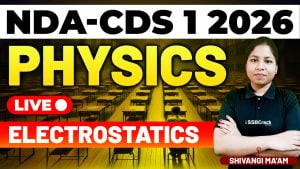Statistics and Probability are essential topics in the NDA-NA Mathematics syllabus. These topics not only contribute significantly to the overall score but also require a strong conceptual understanding and the ability to apply formulas and concepts in problem-solving. In a recent class dedicated to preparing for the NDA-NA exam, students focused on Multiple Choice Questions (MCQs) that covered these topics. This article will highlight the key concepts and strategies needed to excel in Statistics and Probability for the NDA-NA exam.
Understanding Statistics
Statistics involves the collection, analysis, interpretation, and presentation of data. It is a vital tool in various fields and has a strong presence in the NDA-NA exam. The key areas covered in the class were:
Measures of Central Tendency
1. Mean: The mean, or average, is a measure of central tendency that gives an idea of the central value of a data set. Understanding how to calculate the mean for both raw data and grouped data is crucial for solving related MCQs.
2. Median: The median represents the middle value of a data set when arranged in ascending or descending order. It’s important to know how to find the median in various scenarios, especially in grouped data.
3. Mode: The mode is the value that appears most frequently in a data set. For grouped data, understanding how to estimate the mode using interpolation is essential.
Measures of Dispersion
1. Range: The range is the simplest measure of dispersion, calculated as the difference between the highest and lowest values in a data set. While straightforward, it gives a basic idea of variability.
2. Variance and Standard Deviation: Variance measures the average squared deviation from the mean, while the standard deviation is its square root. These are more comprehensive measures of dispersion and are commonly tested in the NDA-NA exam.
3. Quartiles and Interquartile Range (IQR): Quartiles divide data into four equal parts, and the interquartile range measures the spread of the middle 50% of the data. Understanding these concepts is important for solving questions related to data spread.
Understanding Probability
Probability deals with the likelihood of occurrence of events and is a crucial part of the NDA-NA Mathematics syllabus. The key concepts discussed in the class included:
Basic Probability
1. Classical Definition of Probability: The probability of an event is defined as the ratio of the number of favorable outcomes to the total number of possible outcomes. This basic concept is fundamental to understanding more complex probability problems.
2. Conditional Probability: This is the probability of an event occurring given that another event has already occurred. Mastery of conditional probability is essential for solving problems involving dependent events.
3. Independent and Dependent Events: Understanding the difference between independent and dependent events helps in determining how the occurrence of one event affects the probability of another.
Probability Distributions
Binomial Distribution: The binomial distribution is a discrete probability distribution that models the number of successes in a fixed number of independent Bernoulli trials. Recognizing binomial scenarios and calculating probabilities using the binomial formula is crucial.
Strategies for Solving MCQs on Statistics and Probability
Given the variety and complexity of problems in Statistics and Probability, it is important to have effective strategies for tackling MCQs in the NDA-NA exam:
1. Grasp Basic Concepts Thoroughly
Before attempting MCQs, ensure that you have a solid understanding of basic concepts. This includes knowing how to calculate mean, median, mode, variance, and standard deviation, as well as understanding the principles of probability.
2. Recognize the Type of Problem
Quickly identify whether the question is related to statistics or probability. This initial step will help you decide which formulas and concepts to apply. For example, questions on measures of central tendency will involve different approaches compared to probability distribution questions.
3. Use the Process of Elimination
In MCQs, the process of elimination can be a powerful tool. If an option clearly violates a basic statistical rule or probability principle, eliminate it. This strategy can often narrow down your choices and make it easier to find the correct answer.
4. Pay Attention to Keywords
Keywords in the question can guide you toward the correct approach. Words like “average,” “likelihood,” “distribution,” or “given that” can signal which concept or formula to use. This helps in applying the right technique quickly.
5. Practice Time Management
Time management is crucial in the NDA-NA exam. If you encounter a particularly time-consuming problem, mark it and move on to easier questions. Return to it later if time permits. This approach ensures that you maximize your score by solving as many questions as possible.
6. Focus on Common Question Types
Certain types of questions are frequently asked in the NDA-NA exam. For example, problems involving the calculation of mean or standard deviation from grouped data, or finding probabilities using binomial distribution, are common. Familiarize yourself with these question types to improve your speed and accuracy.
7. Use Visualization Where Possible
For problems involving probability distributions, visualizing the distribution curve can be helpful. This is particularly true for normal distribution problems, where understanding the symmetry and spread of the curve can lead to quicker answers.
8. Regular Practice with Past Papers
Regular practice with past NDA-NA papers and mock tests is essential. This not only helps in familiarizing yourself with the exam pattern but also improves your speed, accuracy, and confidence.
Conclusion
Statistics and Probability are vital components of the NDA-NA Mathematics syllabus, and mastering these topics requires a combination of conceptual understanding and strategic problem-solving. By focusing on the key areas highlighted in this article and applying the strategies discussed, you can improve your performance in these topics during the exam.
As you continue your preparation, remember that consistent practice, coupled with a clear understanding of concepts, will be your greatest allies. With the right approach, you can tackle Statistics and Probability questions confidently and effectively, securing a strong performance in the NDA-NA Mathematics paper.

















